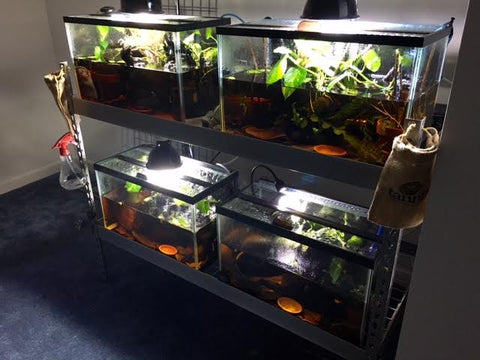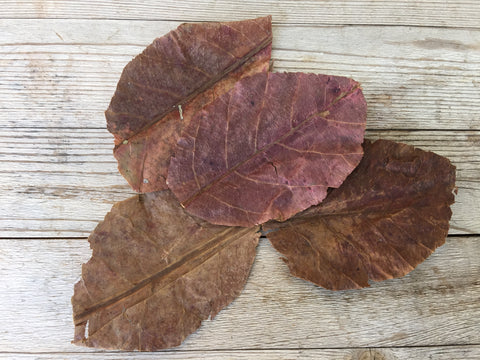- Continue Shopping
- Your Cart is Empty
Leaves, wood, water...life.
Red leaf and yellow leaf
Are flaunting through the air;
The paths are rustling underfoot,
The sun is everywhere.
– William Francis Barnard
As a fish geek who takes more than a little passing interest in the rather obscure practice of adding leaves, seed pods, and other botanical items to aquariums in order to create "blackwater" conditions, I can't help but get excited about the materials.
Yeah, I've spent a good chunk of the last couple of years playing with, sourcing, testing, enjoying- and "romanticizing", if you will, the materials that we use to create these amazing aquatic environments. The "romanticizing" thing is what I'm going to talk about today. Specifically about Catappa leaves, and the difference that it makes to use leaves in your aquascape that are of a certain quality, and that offer a certain "something."

I am a big fan of Indian Almond Leaves (Catappa) in the aquarium. Like many hobbyists who have played with leaves, for many years, I was all about just adding some decent quality materials to my tanks and getting that cool blackwater effect. And it's true, pretty much any old Catappa leaf will impart some tannins to your water, helping to drop the pH a bit and add that "tint" that I won't stop yapping about.
And Catappa leaves are available seemingly everywhere. All over various online sources, eBay, Amazon, etc. And it's never been easier to get them. Very cool times.
And then I started thinking about what makes some leaves better than others.
I mean, have you ever given some thought to the real quality and source of these materials? In other words, is there a difference between random leaves, collected in some village in Southeast Asia, leaves that are touted as "A" grade, or ones that are more expensive, less expensive, pre-packed, or ones that are romantically touted as hand-selected, carefully sourced, and come in a sexy jute bag? (hmm...)

In other words, aren't all leaves essentially the same? Is there really any added value by purchasing our Catappa leaves versus, say, from some random eBay seller?
A scientist will tell you that all Catappa leaves are Terminalia catappa, from a dry-season deciduous tree, and that they turn color before they fall due to the presence of pigments like violaxanthin, zeaxanthin, and lutein. All Catappa leaves contain a number of flavonoids, like kaempferol and quercetin, as well as a number of different tannins, such as punicalin, and tecatin, and saponins and phytosterols. Extracts of T. catappa have shown activity against bacteria, such as Plasmodium falciparum and CQ-sensitive strains. In other words, there is some merit to using them as a fish disease preventative. And all Catappa leaves have these properties, more-or-less.
Yet the similarities end there.

Once the fallen leaves are collected, it's up to the people who handle them to make sure that they are handled in a manner which preserves these unique qualities, or if they become dried out, moldy, or otherwise deteriorate before being shipped to you. And, there is the question of sourcing. It is thought in the horticultural world that different geographic and genetic cultivars of Catappa may contain more-or less concentrations of tannins, possess slightly different leaf morphology, and coloration and durability characteristics.
Now, we're the first to tell you that we are not aware of any specific study that developed a "guide" to which leaves from which area have, say, a higher concentration of phytosterols, etc., nor if tattered leaves have any detrimental affect (they don't, IMHO). I can tell you that we are aware of how well some leaves are collected, processed, stored, handled, and packed. These things ARE pretty important when we're using them in an aquarium. An intact leaf with has literally been hand-selected, carefully processed, and optimally stored before being shipped to you will be different.

Remember, when we offer you leaves at Tannin, they're not solely for the purpose of stimulating fish breeding, or to apply their purported therapeutic properties to your fishes. Sure, you can and should use them for these purposes if you want, but the primary mission of our leaves- the reason we offer the varieties that we do- is to offer certain aesthetics, durability, and to impart the "tint" that we love so much around here. When we select new leaves to add to our collection, those are the primary considerations which we apply.
We realize that not everyone will want pristine-appearing, super-colorful leaves. It's natural to have some variation, and little rips, tears, and blemishes on leaf surfaces are pretty cool, in our minds. Some of you will want "base" materials for your leaf litter, allowing the more "varietal" types of Catappa and other leaves to really shine! We offer those, too.
We have also embarked on a long-term program to bring you different varieties of high quality leaves from a number of carefully vetted sources. We work with outfits with whom we've developed personal relationships and a high degree of trust. Suppliers who understand our needs and our commitment to our customers.
Moving forward, you're going to see a variety of leaves of different origin and source, each one of which will bring a different aesthetic, feel, and quality to your aquarium. The very best will conform to what has been more-or-less developed in the Catappa leaf trade as a "grading system", with the highest quality leaves being designated as "A" grade, and falling under our "Tannin Reserve" designation. Our leaves will be categorized by source and quality. You'll continue to read our romantic musings and stories about leaves, much as you do about gourmet coffee, wine, or cheese!
We'll continue to provide as much impartial, honest, and helpful information about the use of leaves in your aquatic feature. Probably more information than you may care to know...but then again, maybe you will! I think I wrote more than 18 pieces specifically about leaves and their use in aquatic features over the last year...and we're just getting started here!
Why do we go on and on about leaves? And our other botanicals, for that matter?
Because we are crazy about this stuff. And we want to earn your business- and most important-your friendship. And it starts with offering lots of good information in addition to high-quality, value-packed products. And because there is a growing global interest in the botanical-style aquariums, and we're committed to sharing all that we can about them.

And this little aside might give you a bit more insight about where we're coming from:
As we've stated many times before, Tannin Aquatics is not a bargain-priced aquarium vendor, offering tons of "deals" on mass-market stuff and generic items. It's not true to who we are, and not what we choose to bring you. There are plenty of sources for that. In fact, look for a number of our mass-market, widely available product offerings to start disappearing over the next several months, replaced by more unique, more focused merchandise that you'll love. We'll continue to offer fairly-priced, unique, and high-quality stuff, backed with an unwavering commitment to customer service and satisfaction.
Yeah, it really is all about YOU.
We're excited, pleased, and privileged to serve you, to excite you, and to inspire you. And we continue to utilize your feedback to improve. We're about to release some exciting new stuff and continue to refine our selection, packaging, and your customer experience. We have a lot of cool inspirational video and photo materials coming in the next few weeks, providing you with ideas and information to help you create the botanical-influenced aquarium of your dreams!
So, the next time someone tells you that all leaves are "more-or-less the same", you can tell them that essentially they are, but that there are some significant differences, as well.

Then, send them to our site. :)
Until next time. Love the leaves. Stay true to the things that move you. Stay connected. Stay inspired. Stay excited.
And Stay Wet.
Scott Fellman
Tannin Aquatics













Scott Fellman
Author